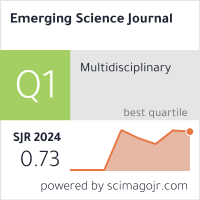The Dual Impact of Corporate Social Responsibility and Digitalization on Bank Financial Stability Efficiency
Downloads
This study investigates the joint effect of corporate social responsibility (CSR) and digitalization on the financial stability efficiency of banks in Vietnam from 2010 to 2022. We construct a CSR index using principal component analysis and employ a one-step stochastic frontier analysis to compute bank stability efficiency based on a forward-looking Z-score. The relationship between CSR, its components, and bank stability efficiency is derived simultaneously through the stable stochastic frontier estimation. Findings reveal a U-shaped relationship between CSR and financial stability efficiency. While CSR investments may initially increase bank instability, aligning with the trade-off theory, they enhance long-term stability. Results underscore that bank managers and board members must commit to CSR initiatives, as the benefits materialize over time. Additionally, this study highlights the moderating role of digitalization, demonstrating that advancements in information technology strengthen the positive relationship between CSR and financial stability efficiency. Further analyses confirm the robustness of findings across state-owned and listed banks and during the COVID-19 pandemic. This research contributes novel insights by integrating CSR, digitalization, and financial stability efficiency, providing actionable strategies for banking sector policymakers and practitioners. The study emphasizes the strategic importance of balancing short-term trade-offs with long-term gains through CSR implementation and leveraging technology to ensure sustainable financial stability.
Downloads
[1] Forcadell, F. J., Aracil, E., & Úbeda, F. (2020). The impact of corporate sustainability and digitalization on international banks’ performance. Global Policy, 11(S1), 18–27. doi:10.1111/1758-5899.12761.
[2] Yuen, M. K., Ngo, T., Le, T. D. Q., & Ho, T. H. (2022). The environment, social and governance (ESG) activities and profitability under COVID-19: Evidence from the global banking sector. Journal of Economics and Development, 24(4), 345–364. doi:10.1108/JED-08-2022-0136.
[3] Salah Mahdi, I. B., Bouaziz, M., & Boujelbène Abbes, M. (2023). The moderating effect of fintech on the relationship between CSR and banks' financial stability: Baron and Kenny's approach analysis. Environmental Science and Pollution Research International. doi:10.1007/s11356-023-31179-z.
[4] Banktrack. (2024). Banking on climate chaos: Fossil fuel finance report 2024. Banktrack, Nijmegen, the Netherlands.
[5] Edwards, W., Jain, R., Soehner, C., Nadeau, M.-C., & Stephens, D. (2023). Green growth: Unlocking sustainability opportunities for retail banks. McKinsey Sustainability, McKinsey & Company, New York, United States.
[6] Hurley, R., Gong, X., & Waqar, A. (2014). Understanding the loss of trust in large banks. International Journal of Bank Marketing, 32(5), 348–366. doi:10.1108/IJBM-01-2014-0003.
[7] Ruiz, B., Esteban, Á., & Gutiérrez, S. (2014). Determinants of reputation of leading Spanish financial institutions among their customers in a context of economic crisis. BRQ Business Research Quarterly, 17(4), 259–278.
[8] Forcadell, F. J., & Aracil, E. (2017). European banks’ reputation for corporate social responsibility. Corporate Social Responsibility and Environmental Management, 24(1), 1–14. doi:10.1002/csr.1402.
[9] Bae, K.-H., El Ghoul, S., Gong, Z., & Guedhami, O. (2021). Does CSR matter in times of crisis? Evidence from the COVID-19 pandemic. Journal of Corporate Finance, 67, 101876. doi:10.1016/j.jcorpfin.2020.101876.
[10] Deyoung, R., Lang, W. W., & Nolle, D. L. (2007). How the Internet affects output and performance at community banks. Journal of Banking & Finance, 31(4), 1033–1060. doi:10.1016/j.jbankfin.2006.10.003.
[11] Le, T. D. Q., & Ngo, T. (2020). The determinants of bank profitability: A cross-country analysis. Central Bank Review, 20(2), 65–73. doi:10.1016/j.cbrev.2020.04.001.
[12] Singh, R., Bansal, R., & Singh, V. P. (2022). Industry 4.0: Driving the digital transformation in banking sector. In M. Niranjanamurthy, S.-L. Peng, E. Naresh, S. R. Jayasimha & V. E. Balas (Eds.), Advances in Industry 4.0, De Gruyter , 51–64. doi:10.1515/9783110725490.
[13] Dell’Ariccia, G. (2001). Asymmetric information and the structure of the banking industry. European Economic Review, 45(10), 1957–1980. doi:10.1016/S0014-2921(00)00085-4.
[14] Nguyen, Q. T. T., Ho, L. T. H., & Nguyen, D. T. (2023). Digitalization and bank profitability: Evidence from an emerging country. International Journal of Bank Marketing. Advance online publication, 156. doi:10.1108/IJBM-03-2023-0156.
[15] Theiri, S., & Hadoussa, S. (2023). Digitization effects on banks’ financial performance: The case of an African country. Competitiveness Review: An International Business Journal, 34(1), 144–162. doi:10.1108/CR-10-2022-0147.
[16] Bian, W., Wang, S., & Xie, X. (2023). How valuable is FinTech adoption for traditional banks? European Financial Management. doi:10.1111/eufm.12424.
[17] He, M., Song, G., & Chen, Q. (2023). Fintech adoption, internal control quality and bank risk taking: Evidence from Chinese listed banks. Finance Research Letters, 57, 104235. doi:10.1016/j.frl.2023.104235.
[18] Skýpalová, R., Bohušová, H., & Křápek, M. (2024). Preparedness for Mandatory CSR Reporting of Multinational Companies: Case of the Czech Republic. Emerging Science Journal, 8(3), 1016–1036. https://doi.org/10.28991/esj-2024-08-03-013.
[19] World Bank. (2023). World Development Indicators. Washington, D.C, United States.
[20] Asian Development Bank. (2020). Viet Nam’s economy to remain one of the fastest growing in Asia despite sharp slowdown due to COVID‑19. Asian Development Bank, Philippines.
[21] Le, T. D., Tran, S. H., Ngo, T., & Bui, H. D. (2024). Predicting Vietnam’s economic growth using machine learning approaches. Empirical Economics Letters, 23(2), 119–135. doi:10.5281/zenodo.10893067.
[22] Le, T., Nguyen, D. T., Ho, T. H., & Ngo, T. (2024). Government intervention and stock price returns during COVID‑19 pandemic: Evidence from an emerging market. Cogent Business & Management, 11(1), 2376042. doi:10.1080/23311975.2024.2376042.
[23] Boubaker, S., Le, T. D., & Ngo, T. (2022). Managing bank performance under COVID‑19: A novel inverse DEA efficiency approach. International Transactions in Operational Research, 30, 2436–2452. doi:10.1111/itor.13132.
[24] Le, T., Tran, S. H., & Nguyen, L. T. (2019). The impact of multimarket contacts on bank stability in Vietnam. Pacific Accounting Review, 31(3), 336–357. doi:10.1108/PAR-04-2018-0033.
[25] Le, T., Ngo, T., Nguyen, D. T., & Do, T. T. M. (2024). Fintech and banking: friends or foes? Evidence from bank–fintech cooperation. International Journal of Bank Marketing. Advance online publication, 525. doi:10.1108/IJBM-09-2023-0525.
[26] State Bank of Vietnam. (2015a). Decision No. 1552/QD‑NHNN on the action plan of the banking sector for implementation of the national strategy for green growth by 2020. State Bank of Vietnam, Hanoi, Vietnam.
[27] State Bank of Vietnam. (2015b). Directive No. 03/CT‑NHNN on promoting green credit growth and environmental–social risks management in credit-granting activities. State Bank of Vietnam, Hanoi, Vietnam.
[28] Fang, Y., Hasan, I., & Marton, K. (2014). Institutional development and bank stability: Evidence from transition countries. Journal of Banking & Finance, 39, 160–176. doi:10.1016/j.jbankfin.2013.11.003.
[29] Vo, D. H., Tran, N. P., Hoang, H. T.-T., & Van, L. T.-H. (2022). Do corporate social responsibility and bank performance matter for financial inclusion in Vietnam? Journal of Asia Business Studies, 16(4), 639–651. doi:10.1108/JABS-11-2020-0462.
[30] Nguyen, L. T., & Nguyen, K. V. (2021). The impact of corporate social responsibility on the risk of commercial banks with different levels of financial constraint. Asia-Pacific Journal of Business Administration, 13(1), 98–116.
[31] Tan, N. (2017). The official introduction of GRI standards in Vietnamese. Ho Chi Minh Government Official Press, Ho Chi Minh City, Vietnam.
[32] Zhou, G., Sun, Y., Luo, S., & Liao, J. (2021). Corporate social responsibility and bank financial performance in China: The moderating role of green credit. Energy Economics, 97, 105190. doi:10.1016/j.eneco.2021.105190.
[33] Pham, T. P., Pavelkova, D., Popesko, B., Hoang, S. D., & Huynh, H. T. (2024). Relationship between fintech by Google search and bank stock return: A case study of Vietnam. Financial Innovation, 10(1), 123. doi:10.1186/s40854-023-00576-1.
[34] Le, T. (2023). A shift towards household lending during Fintech era: The role of financial literacy and credit information sharing. Asia‑Pacific Journal of Business Administration, 15(3), 466–485. doi:10.1108/APJBA-07-2021-0325.
[35] Le, T., Ngo, T., Nguyen, D. T., & Do, T. T. M. (2023). Digital credit and its determinants: A global perspective. International Journal of Financial Studies, 11(4), 124. doi:10.3390/ijfs11040124.
[36] Yudaruddin, R. (2023). Financial technology and performance in Islamic and conventional banks. Journal of Islamic Accounting and Business Research, 14(1), 100–116. doi:10.1108/JIABR-03-2022-0070.
[37] Kumhof, M., & Noone, C. (2021). Central bank digital currencies — Design principles for financial stability. Economic Analysis and Policy, 71, 553–572. doi:10.1016/j.eap.2021.06.012.
[38] Le, T., Tran, S. H., Nguyen, D. T., & Ngo, T. (2023b). The degrees of central bank digital currency adoption across countries: A preliminary analysis. Economics and Business Letters, 12(2), 97–104. doi:10.17811/ebl.12.2.2023.97-104.
[39] Ben Ali, M. (2022). Digitalization and banking crisis: A nonlinear relationship? Journal of Quantitative Economics, 20(2), 421–435. doi:10.1007/s40953-022-00292-0.
[40] Khattak, M. A., Ali, M., Azmi, W., & Rizvi, S. A. R. (2023). Digital transformation, diversification and stability: What do we know about banks? Economic Analysis and Policy, 78, 122–132. doi:10.1016/j.eap.2023.03.004.
[41] Diamond, D. (1984). Financial intermediation and delegated monitoring. The Review of Economic Studies, 51(3), 393–414. doi:10.2307/2297430.
[42] Allen, F., & Santomero, A. M. (1997). The theory of financial intermediation. Journal of Banking & Finance, 21(11), 1461–1485. doi:10.1016/S0378-4266(97)00032-0.
[43] Scholtens, B. (2009). Corporate social responsibility in the international banking industry. Journal of Business Ethics, 86(2), 159–175. doi:10.1007/s10551-008-9841-x.
[44] George, G., Haas, M. R., & Pentland, A. (2014). Big data and management. Academy of Management Journal, 57(2), 321–326. doi:10.5465/amj.2014.4002.
[45] Hu, D., Zhao, S., & Yang, F. (2022). Will fintech development increase commercial banks risk‑taking? Evidence from China. Electronic Commerce Research, 24, 37–67. doi:10.1007/s10660-022-09538-8.
[46] Berger, A. N., & DeYoung, R. (2006). Technological progress and the geographic expansion of the banking industry. Journal of Money, Credit and Banking, 38(6), 1483–1513. doi:10.1353/mcb.2006.0077.
[47] Simper, R., Dadoukis, A., & Bryce, C. (2019). European bank loan loss provisioning and technological innovative progress. International Review of Financial Analysis, 63, 119–130. doi:10.1016/j.irfa.2019.03.001.
[48] Berger, A. (2003). The economic effects of technological progress: Evidence from the banking industry. Journal of Money, Credit and Banking, 35(2), 141–176.
[49] Beccalli, E. (2007). Does IT investment improve bank performance? Evidence from Europe. Journal of Banking & Finance, 31(7), 2205–2230. doi:10.1016/j.jbankfin.2006.10.022.
[50] Martín‑Oliver, A., & Salas‑Fumás, V. (2008). The output and profit contribution of information technology and advertising investments in banks. Journal of Financial Intermediation, 17(2), 229–255. doi:10.1016/j.jfi.2007.10.001.
[51] Ngo, T., & Le, T. (2022). Impact of information and communication technology on banking efficiency: The Vietnamese experience. Handbook of Banking and Finance in Emerging Markets. Edward Elgar Publishing, Cheltenham, United Kingdom.
[52] Dinçer, H., & Yüksel, S. (2020). The role of IT investment on bank performance: A cointegration and causality analysis for Asian countries. Role of IT‑ITES in Economic Development of Asia. Academic Press, New Delhi, India.
[53] Appiahene, P., Missah, Y. M., & Najim, U. (2019). Evaluation of information technology impact on bank’s performance: The Ghanaian experience. International Journal of Engineering Business Management, 11. doi:10.1177/1847979019835337.
[54] Le, T., Ngo, T., Ho, T. H., & Nguyen, D. T. (2022). ICT as a Key Determinant of Efficiency: A Bootstrap-Censored Quantile Regression (BCQR) Analysis for Vietnamese Banks. International Journal of Financial Studies, 10(2), 44. doi:10.3390/ijfs10020044.
[55] Acharya, R. N., Kagan, A., & Rao Lingam, S. (2008). Online banking applications and community bank performance. International Journal of Bank Marketing, 26(6), 418–439. doi:10.1108/02652320810902442.
[56] Owusu Kwateng, K., Osei‑Wusu, E. E., & Amanor, K. (2020). Exploring the effect of online banking on bank performance using data envelopment analysis. Benchmarking: An International Journal, 27(1), 137–165. doi:10.1108/BIJ-06-2018-0154.
[57] Holden, K., & El‑Bannany, M. (2004). Investment in information technology systems and other determinants of bank profitability in the UK. Applied Financial Economics, 14(5), 361–365. doi:10.1080/0960310042000211623.
[58] Valverde, S. C., & Humphrey, D. B. (2009). Technological innovation in banking: The shift to ATMs and implicit pricing of network convenience. In L. Anderloni, D. T. Llewellyn & R. H. Schmidt (Eds.), Financial Innovation in Retail and Corporate Banking. Springer, Berlin, Germany.
[59] Wang, Y., Xiuping, S., & Zhang, Q. (2021). Can fintech improve the efficiency of commercial banks? — An analysis based on big data. Research in International Business and Finance, 55, 101338. doi:10.1016/j.ribaf.2020.101338.
[60] Sathye, S., & Sathye, M. (2017). Do ATMs increase technical efficiency of banks in a developing country? Evidence from Indian banks. Australian Accounting Review, 27(1), 101–111. doi:10.1111/auar.12110.
[61] DeYoung, R. (2001). The financial performance of pure play Internet banks. Economic Perspectives (Q1), 25(1), 60–78.
[62] Scholz, R. W. (2017). Digital threat and vulnerability management: The SVIDT method. Sustainability, 9(4), 554. doi:10.3390/su9040554.
[63] Brenner, B. (2018). Transformative sustainable business models in the light of the digital imperative—a global business economics perspective. Sustainability, 10(12), 4428. doi:10.3390/su10124428.
[64] Helbing, D. (2015). Thinking ahead‑essays on big data, digital revolution, and participatory market society. Springer, Cham, Switzerland.
[65] Yar, M., & Steinmetz, K. F. (2019). Cybercrime and society. SAGE Publications, Thousand Oaks, United States.
[66] Ragnedda, M., & Muschert, G. W. (2015). The digital divide: The Internet and social inequality in international perspective. Routledge, London, United Kingdom.
[67] Cho, S. Y., Lee, C., & Pfeiffer, R. J. (2013). Corporate social responsibility performance and information asymmetry. Journal of Accounting and Public Policy, 32(1), 71–83. doi:10.1016/j.jaccpubpol.2012.10.005.
[68] Diebecker, J., & Sommer, F. (2017). The impact of corporate sustainability performance on information asymmetry: The role of institutional differences. Review of Managerial Science, 11(2), 471–517. doi:10.1007/s11846-016-0195-y.
[69] Herzig, C., & Moon, J. (2013). Discourses on corporate social ir/responsibility in the financial sector. Journal of Business Research, 66(10), 1870–1880. doi:10.1016/j.jbusres.2013.02.008.
[70] Cui, J., Jo, H., & Na, H. (2018). Does corporate social responsibility affect information asymmetry? Journal of Business Ethics, 148(3), 549–572. doi:10.1007/s10551-015-3003-8.
[71] Klewes, J., & Wreschniok, R. (2009). Reputation capital: Building and maintaining trust in the 21st century (pp. 1–20). Berlin, Germany: Springer.
[72] Kim, G., Shin, B., & Lee, H. G. (2009). Understanding dynamics between initial trust and usage intentions of mobile banking. Information Systems Journal, 19(3), 283–311. doi:10.1111/j.1365-2575.2007.00269.x.
[73] Hoepner, A., Oikonomou, I., Scholtens, B., & Schröder, M. (2016). The effects of corporate and country sustainability characteristics on the cost of debt: An international investigation. Journal of Business Finance & Accounting, 43(1–2), 158–182.
[74] Dyer, J. (1997). Effective interim collaboration: How firms minimize transaction costs and maximise transaction value. Strategic Management Journal, 18(7), 535–556. doi:10.1002/(SICI)1097-0266(199708)18:7<535::AID-SMJ885>3.0.CO;2-Z.
[75] Cornett, M. M., Erhemjamts, O., & Tehranian, H. (2016). Greed or good deeds: An examination of the relation between corporate social responsibility and the financial performance of U.S. commercial banks around the financial crisis. Journal of Banking & Finance, 70, 137–159. doi:10.1016/j.jbankfin.2016.04.024.
[76] Esteban‑Sanchez, P., de la Cuesta‑Gonzalez, M., & Paredes‑Gazquez, J. D. (2017). Corporate social performance and its relation with corporate financial performance: International evidence in the banking industry. Journal of Cleaner Production, 162, 1102–1110. doi:10.1016/j.jclepro.2017.06.127.
[77] Maqbool, S., & Zameer, M. N. (2018). Corporate social responsibility and financial performance: An empirical analysis of Indian banks. Future Business Journal, 4(1), 84–93. doi:10.1016/j.fbj.2017.12.002.
[78] Belasri, S., Gomes, M., & Pijourlet, G. (2020). Corporate social responsibility and bank efficiency. Journal of Multinational Financial Management, 54, 100612. doi:10.1016/j.mulfin.2020.100612.
[79] Preston, L. E., & O’Bannon, D. P. (1997). The corporate social‑financial performance relationship: A typology and analysis. Business & Society, 36(4), 419–429. doi:10.1177/000765039703600406.
[80] Alexander, G. J., & Buchholz, R. A. (1978). Corporate social responsibility and stock market performance. Academy of Management Journal, 21(3), 479–486. doi:10.5465/255728.
[81] Barnea, A., & Rubin, A. (2010). Corporate social responsibility as a conflict between shareholders. Journal of Business Ethics, 97(1), 71–86. doi:10.1007/s10551-010-0496-z.
[82] Platonova, E., Asutay, M., Dixon, R., & Mohammad, S. (2018). The impact of corporate social responsibility disclosure on financial performance: Evidence from the GCC Islamic banking sector. Journal of Business Ethics, 151(2), 451–471. doi:10.1007/s10551-016-3229-0.
[83] Andrieș, A. M., & Sprincean, N. (2023). ESG performance and banks’ funding costs. Finance Research Letters, 54, 103811. doi:10.1016/j.frl.2023.103811.
[84] Di Tommaso, C., & Thornton, J. (2020). Do ESG scores affect bank risk taking and value? Evidence from European banks. Corporate Social Responsibility and Environmental Management, 27(5), 2286–2298. doi:10.1002/csr.1964.
[85] Su, W., Peng, M. W., Tan, W., & Cheung, Y. L. (2016). The signaling effect of corporate social responsibility in emerging economies. Journal of Business Ethics, 134(3), 479–491. doi:10.1007/s10551-014-2404-4.
[86] Al‑Qudah, A. A., Hamdan, A., Al‑Okaily, M., & Alhaddad, L. (2023). The impact of green lending on credit risk: Evidence from UAE’s banks. Environmental Science and Pollution Research, 30(22), 61381–61393. doi:10.1007/S11356-021-18224-5.
[87] Fiordelisi, F., & Marques‑Ibanez, D. (2013). Is bank default risk systematic? Journal of Banking & Finance, 37(6), 2000–2010. doi:10.1016/j.jbankfin.2013.01.004.
[88] Le, T. (2021). Geographic expansion, income diversification, and bank stability: Evidence from Vietnam. Cogent Business & Management, 8(1), 1885149. doi:10.1080/23311975.2021.1885149.
[89] Laeven, L., & Levine, R. (2009). Bank governance, regulation and risk taking. Journal of Financial Economics, 93(2), 259–275. doi:10.1016/j.jfineco.2008.09.003.
[90] Hafeez, B., Li, X., Kabir, M. H., & Tripe, D. (2022). Measuring bank risk: Forward‑looking z‑score. International Review of Financial Analysis, 80, 102039. doi:10.1016/j.irfa.2022.102039.
[91] Leibenstein, H. (1966). Allocative efficiency vs. “X‑efficiency”. The American Economic Review, 56(3), 392–415.
[92] Berger, A. N., & Mester, L. J. (1997). Inside the black box: What explains differences in the efficiencies of financial institutions? Journal of Banking & Finance, 21, 895–947.
[93] Battese, G. E., & Coelli, T. J. (1995). A model for technical inefficiency effects in a stochastic frontier production function for panel data. Empirical Economics, 20, 325–332.
[94] Kumbhakar, S. C., & Lovell, C. K. (2003). Stochastic frontier analysis. Cambridge, UK: Cambridge University Press.
[95] Wang, H.‑j., & Schmidt, P. (2002). One‑step and two‑step estimation of the effects of exogenous variables on technical efficiency levels. Journal of Productivity Analysis, 18(2), 129–144. doi:10.1023/A:1016565719882.
[96] Horváthová, E. (2010). Does environmental performance affect financial performance? A meta‑analysis. Ecological Economics, 70(1), 52–59.
[97] Avkiran, N. (2011). Association of DEA super‑efficiency estimates with financial ratios: Investigating the case for Chinese banks. Omega, 39(3), 323–334. doi:10.1016/j.omega.2010.08.001.
[98] Ho, T. H., Nguyen, D. T., Ngo, T., & Le, T. D. Q. (2021). Efficiency in Vietnamese banking: A meta‑regression analysis approach. International Journal of Financial Studies, 9(3), 41.
[99] Ho, T. H., Nguyen, D. T., Luu, T. B., Le, T. D. Q., & Ngo, T. D. (2023). Bank performance during the COVID‑19 pandemic: Does income diversification help? Journal of Applied Economics, 26(1), 2222964. doi:10.1080/15140326.2023.2222964.
[100] Ngo, T., & Le, T. (2019). Capital market development and bank efficiency: A cross‑country analysis. International Journal of Managerial Finance, 15(4), 478–491. doi:10.1108/IJMF-02-2018-0048.
[101] Brammer, S., & Millington, A. (2008). Does it pay to be different? An analysis of the relationship between corporate social and financial performance. Strategic Management Journal, 29(12), 1325–1343.
[102] Azmi, W., Hassan, M. K., Houston, R., & Karim, M. S. (2021). ESG activities and banking performance: International evidence from emerging economies. Journal of International Financial Markets, Institutions and Money, 70, 101277.
[103] Wang, H., Choi, J., & Li, J. (2008). Too little or too much? Untangling the relationship between corporate philanthropy and firm financial performance. Organization Science, 19(1), 143–159. doi:10.1287/orsc.1070.0271.
[104] Buallay, A. (2019). Corporate governance, CSR disclosure and firm performance: Evidence from Saudi Arabia. Academy of Accounting and Financial Studies Journal, 23(3), 1–17.
[105] Berger, A. N., & Mester, L. J. (2003). Explaining the dramatic changes in performance of U.S. banks: Technological change, deregulation, and dynamic changes in competition. Journal of Financial Intermediation, 12(1), 57–95.
[106] Machkour, B., & Abriane, A. (2020). Industry 4.0 and its implications for the financial sector. Procedia Computer Science, 177, 496–502. doi:10.1016/j.procs.2020.10.068.
[107] Ngo, T., & Tripe, D. (2017). Measuring efficiency of Vietnamese banks: Accounting for nonperforming loans in a single‐step stochastic cost frontier analysis. Pacific Accounting Review, 29(2), 171–182. doi:10.1108/PAR-06-2016-0064.
[108] Nguyen, T. P. T., Nghiem, S. H., Roca, E., & Sharma, P. (2016). Bank reforms and efficiency in Vietnamese banks: Evidence based on SFA and DEA. Applied Economics, 48(30), 2822–2835. doi:10.1080/00036846.2015.1130788.
[109] Shen, C.‑H., Wu, M.‑W., Chen, T.‑H., & Fang, H. (2016). To engage or not to engage in corporate social responsibility: Empirical evidence from global banking sector. Economic Modelling, 55, 207–225.
[110] Wu, M. W., & Shen, C. H. (2013). Corporate social responsibility in the banking industry: Motives and financial performance. Journal of Banking & Finance, 37(9), 3529–3547. doi:10.1016/j.jbankfin.2013.04.023.
[111] Del Gaudio, B. L., Porzio, C., Sampagnaro, G., & Verdoliva, V. (2021). How do mobile, Internet and ICT diffusion affect the banking industry? An empirical analysis. European Management Journal, 39(3), 327–332. doi:10.1016/j.emj.2020.07.003.
[112] Chi, L. H. D., & Hang, B. T. T. (2023). Corporate social responsibility expenditure and financial performance: A comparison of Vietnamese listed and unlisted banks. Cogent Economics & Finance, 11(1), 2203987.
- This work (including HTML and PDF Files) is licensed under a Creative Commons Attribution 4.0 International License.




















